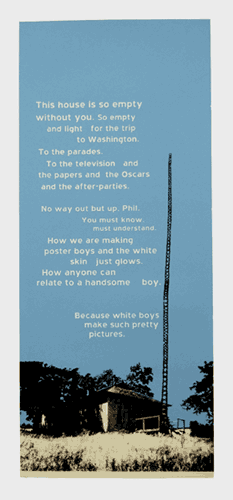
The Disappearance of Phillip DeVine, 2007
screenprint
On December 31, 1993, three young people were killed in a farmhouse in Humbolt, Nebraska. Brandon Teena, a white transgender man, Lisa Lambert, a white single mother who lived in the farmhouse, and Phillip DeVine, a black man in town visiting his girlfriend, were killed by two men, John Lotter and Tom Nissen. John and Tom had recently befriended Brandon, and knew Lisa and Phillip from their social circle around town and in nearby Falls City. They came to the farmhouse looking to silence Brandon, whom they’d raped and beaten a week before when they found out he was born female.
In the decade following the killings, Brandon’s case became a symbol of anti-transgender violence, crossing into the national spotlight with the success of the film Boys Don’t Cry. However, as Brandon’s story got bigger, the complexities of class, race, and gender—arguably the structural and real causes of not only his death, but those of Phillip and Lisa, as well—fell by the wayside. In Boys Don’t Cry’s Hollywood version of the story, Phillip DeVine was made invisible, his character erased, his name not even included in the memorial text at the end of the film. This, and other similar disappearances, makes it necessary to ask what sacrifices are made to construct idealized lesbian, gay, bisexual, and transgender stories for mass consumption.






